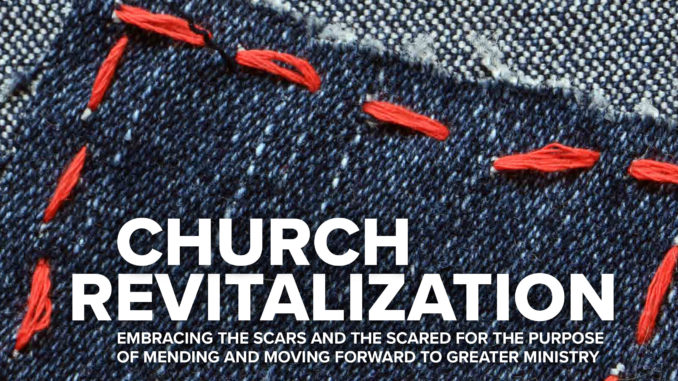
For as long as I can remember, whether it was in “snack shop theology” sessions with friends or more “official” conversations at Fellowship Meetings, the unanswerable question has always been, which is easier, planting a new church or resurrecting a dying church?
I love the focus our Fellowship has put on church planting. I pastor and serve as Vice Chairman for the Texas Baptist Bible Fellowship and church planting is at the very top of our priority list. If we are going to continue to send missionaries to other countries to preach and plant churches, we must have new churches here to help bear the weight of that support, especially in the areas of our nation that are growing at an almost unbelievable pace. As a movement, we realize we have not kept up.
Recently an additional focus has emerged. It is the other half of the unanswerable question. Resurrecting dying and plateaued churches has now found a new place in the dialog, both in our movement and evangelicalism at large. Now called revitalization, the effort to help churches in decline be vibrant again has become a much-needed focus. Revitalization has always existed, but now it has been given a legitimate voice in the conversation. When one reads the alarming statistics compiled by men like Ed Stetzer and Thom Rainer, that between 70 and 80 percent of churches are plateaued or in decline, it is no wonder revitalization has sprung to the forefront of the conversation. In very recent years, resources have become readily available, and more are coming out all the time. You can even receive articles, blogs, and podcasts on revitalization from the likes of Rainer and Cary Nieuwhof in your inbox almost every morning. Academic institutions are now offering advanced degrees in church revitalization. We have come to the realization that breaking even between new churches being planted and existing churches closing their doors is not going to reach the world with the gospel.
My first pastorate would be considered a revitalization in that we changed several paradigms to facilitate reaching new people and for several years we became the fastest growing church in our city. Then through a series of events, we lost that momentum. I once heard John Maxwell describe momentum in terms of a freight train. As long as a train is running full speed it can plow through a concrete wall. But if it ever stops, a small piece of wood under the front wheels will keep it from moving forward again. I have experienced both ends of that spectrum. Looking back on it, I have learned that in any given situation things are probably not as good or bad as we think they are.
Currently I am about to enter my fifth year of a revitalization challenge that has been a much slower turn around than I had anticipated. I thank God for the reports I read of churches that turn around quickly and experience amazing results. They encourage me. But that has not been my experience. When God called us to our present ministry, we knew some difficult times were ahead. We found a group of people who were reeling. They were hurting spiritually, numerically, financially, and many had lost their trust in leadership. It took two years before I fully understood how deep some of those hurts were. Over nearly five years God has taught me some important lessons as we have waded through the mud to greener pastures. I offer these insights from that perspective. I offer them as suggestions to leaders. Your experience may be different than mine. Every church is different. As many books as I have read on revitalization, the thing that keeps leaping to my mind is that none of those authors have ever been in my church. They do not know my people so their strategies cannot be one size fits all. As helpful as resources are, I believe revitalization is endemic.
The first book I read on revitalization was Bill Henard’s, Can These Bones Live? I highly recommend it. It gave me legs to experience some of what I suggest to you now.
Honestly evaluate your situation.
Whether you are the existing leader or coming in from the outside, honest evaluation of the situation is the first priority. If the decline has happened under your watch, you must decide if you have the energy and vision to spark revitalization. This is not to assume blame. There are an endless number of reasons churches go into decline. Sometimes the leader who sees the decline is not the one to turn it around. Sometimes he is the only one who can turn it around. All I am saying is be honest in your evaluation. If you are considering stepping into a situation from the outside, be sure you have the stamina and skill set to be effective. If you do not, the church will likely die, and it will go on your resume. A sincere time of prayer and evaluation are the first steps every time.
Your number one investment will be time.
Regaining momentum takes time regardless of the reason it was lost. If you are not willing or able to see it all the way through, it is better not to begin at all. I have always heard it takes five years for a church to let a man really become their pastor. It takes longer if the church has been wounded.
If you step in to an existing situation, do your homework to understand it.
I had no idea how great my learning curve was going to be. Just last week I heard a story I had not heard in nearly five years and it turned a light on as to why a situation was playing out like it was. I am still learning. One key to revitalization is listening to people tell their stories.
Don’t make promises you can’t keep.
Pastors and ministry leaders are fixers. We see something broken and we devise plans to fix it. It is what we do. I have learned it is best to measure your words carefully and not promise results, especially if you go into a situation where trust has been damaged. Making promises you can’t keep will insert you into the damaged trust department and reversing that can be almost impossible. You are not the hero riding in on a white horse to save the day. You are a shepherd who is about to get down in the dirt with injured sheep and find a way to get them to follow you to greener pastures.
Give people permission to grieve their losses.
A church that has faced any kind of heartache will naturally turn inward. They will move into survival mode. I had to learn to give them time to grieve what they had lost. All leaders know that ultimately it is outreach that turns a church around, but I learned quickly that challenging them with outreach immediately would have been a disaster. Seeping wounds needed time to heal. Now that healing has taken place, outreach is happening, and we are starting to see people come to Christ and we are starting to see growth. I have come to deeply love the people who went through the heartache and stayed. I also understand why some feel they cannot stay in certain situations. Giving people time to grieve their losses has set a wonderful foundation for moving forward. Even at that, the question tends to be, “Will things ever get back to the way they used to be?” In revitalization, what used to be is not the measuring stick. Where you are and what can be in the future is the measuring stick.
Find the influencers and get them on your side.
Nearly every church “how to” book has a chapter on this. That is because it is a universal principle. If your train has stopped you need people who will help you push it forward, not people who only want to whine about why it stopped or can only talk about the good old days when it used to steam down the track. The right team around you is vitally important, whether it is staff on the payroll or volunteers. Leadership is not a position, it is influence. If you are stepping into a new situation, observation will tell you who the people follow. Target the leaders and let them help you plant and carry forth a new vision when the time is right.
Don’t make radical changes too quickly unless the church’s survival is at stake. In that case, lance the boil as soon as possible.
A church in decline, especially if it has been injured, is already hemorrhaging. Don’t add to it foolishly. When it comes to making changes, timing is everything. If a major change must be implemented quickly for the church to survive, be completely transparent about it. Explain why the change is necessary and how the new plan will fix it. Then make the change. You are an agent of rescue. Use the paddles if needed, but never recklessly to fulfill your own preferences.
Keep difficulties and negatives behind the scenes as much as possible.
Revitalization will require replacing existing systems and structures. Much of that can be done without a lot of fanfare. Every negative that caused the decline will have to be addressed and changed, but I have found it is better to keep the work on those things limited to a few key leaders rather than addressing all of the negatives publicly.
Always be completely honest with the church.
When there are negatives that MUST BE addressed publically, be totally transparent about them. One of the greatest challenges is to address a situation where your hands are tied because things were not handled transparently by predecessors who no doubt believed things would be smoother by not giving all of the details. ALWAYS tactfully tell the congregation the whole truth, no matter how difficult it may be. You will be much better off in the long run.
Urge people to be positive publically.
In the world of social media, negatives are abundant. Sometimes something as simple as a former member checking in at another church across town can be the seeds of an ugly confrontation in the cyber world. From the first day, I have encouraged our people to check in on Facebook when they are at church and then comment something positive about the service. This projects a positive image and gives them a personal strategy for finding the positives in the middle of negatives. I have also encouraged them to respond to questions positively, especially to people who know their church has experienced crisis. “It was rough there for a while, but things are turning around now” is a wonderful statement to turn a conversation in a positive direction.
Celebrate even the smallest victories publically.
Look for reasons to celebrate the changes God is making and give Him all of the glory.
Church Revitalization is not for the faint of heart, but if God places you in a situation to rescue a declining or dying church, He will equip you with what you need to do the job. As for us, we have turned the corner. We are starting to reach multiple generations, the spirit in our services is fresh and exciting. We have assembled a fantastic team to lead us into the future, and outreach is becoming a major focus again. The people who went through the decline and stayed are the most excited about the future because they know the church they have invested their lives in is strong and moving forward again. A few have also returned, and their excitement now is palpable. Yes, “these bones can live,” and church revitalization is absolutely worth it.

